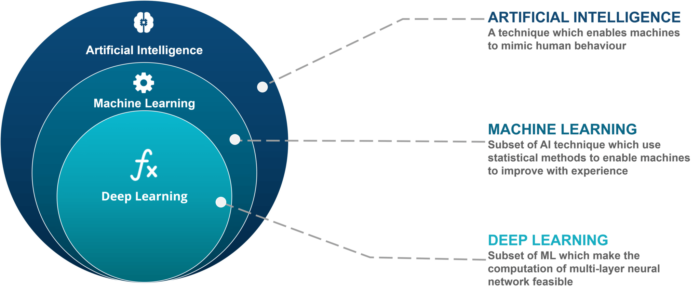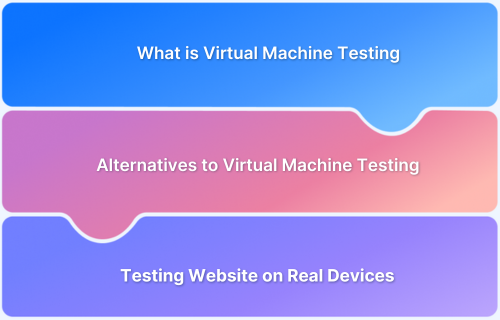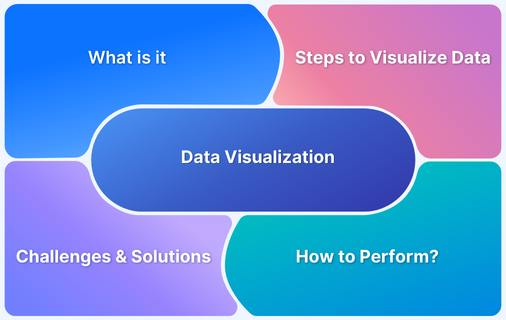Machine Learning (ML) is transforming automation testing by bringing intelligence into the testing process. It uses data and algorithms to mimic human learning and adapt over time, enabling smarter test execution, faster feedback, and more accurate results.
As software systems grow more complex, ML helps teams keep pace by making testing faster, smarter, and more efficient.
Overview
What is Machine Learning
Machine Learning (ML) is a subtype of Artificial Intelligence that assists machines in accessing knowledge and completing various tasks. ML technology assists AI systems in comprehending learning techniques and obtaining insights.
Applications of Machine Learning in Test Automation
- Handle massive test data
- Make precise quality judgments
- Improve test reliability In typical test automation programs
- Continuous Testing and Predictive Analytics
- Natural Language Processing (NLP) for Test Automation
- Visual Testing
Benefits of Using Machine Learning in Software Testing
- Predictive analytics
- Self-healing tests
- Faster feedback
- Enhanced accuracy
- Smart test automation
Understanding Machine Learning
Machine learning uses computational methods to learn information from data directly without requiring an existing equation as a model.
These three essential components of machine learning are:
- A Decision Process: ML algorithms are often used to create a prediction or categorization. The algorithms will provide an approximation about a trend in the data dependent on particular data input that can be tagged or unmarked.
- An Error Function: The error function is used to analyze the model’s predictions. If there are known instances, an error function may compare them to determine the model’s correctness.
- Model Optimization: Weights are adjusted to close the gap between the model prediction and the standout example if the model performed well on the training data sets. Up until a limit is reached, the algorithm would automatically update values as it continues to evaluate and optimize the process.
Machine Learning and Artificial Intelligence
Artificial intelligence, or AI, focuses on imitating human intellect in machines. The primary objective of AI technology is to create a problem-solving method that enables software to manage activities without requiring manual programming. Artificial intelligence seeks to imbibe software with thinking, sensing, and decision-making abilities.
However, Machine Learning is a subtype of Artificial Intelligence that assists machines in accessing knowledge and completing various tasks. The ML technology assists AI systems in comprehending the learning techniques and obtaining insights.
Difference between AI and ML
Here are the main differences between AI and ML:
| Machine learning | Artificial Intelligence |
|---|---|
| Method of data analysis that automates analytical model building. | Method of data analysis that makes your model intelligent. |
| Machine learning results in data. | Artificial Intelligence results in knowledge. |
| The aim is to extend accuracy. | The aim is to extend the probability of success. |
| Machine learning is the process of extracting information from data. | Artificial intelligence is a computer science area that creates computer systems that can replicate human intellect. |
| It can only accomplish tasks that the system is trained to do. | Capable of performing complex tasks. |
| The scope is limited. | Has a wide variety of applications. |
| Finds solutions | Finds optimal solutions |
Read More: A Detailed Guide on Automation Scripts
Automated Machine Learning
Automated machine learning presents a significant shift in how businesses of all sizes view data science and machine learning. Traditional machine learning approaches are time-consuming, resource-intensive, and difficult to apply to real-world scenarios. It requires expertise in various fields, including data scientists, who are among the most in-demand individuals in the employment market just now.
Automated machine learning alters these processes by executing systematic procedures on raw data and picking models that draw the most critical knowledge from big data – commonly referred to as “the pattern in the noise.” Automated machine learning contains top-ranked practices to ensure that data science is increasingly approachable across the board.
The key to achieving effective test automation lies in its execution. Achieving faster releases at scale and quality is the end goal. Learn how to optimize test automation for speed, robustness, and increased coverage.
Using Machine Learning in Test Automation
Test automation uses testing instruments to create test scripts with the necessary input variables and run them to obtain the results. The only manual labor required is to specify the test instance in the manner of a computer script, and the tool handles the remainder of the testing procedure.
Despite its advantages, test automation does have a disadvantage: it requires ongoing and persistent monitoring when testing software is updated. To address this issue, ML steps in.
Machine learning model assists in automatically generating and updating test cases, detecting flaws, and improving the current code scope. As a result, it supports businesses in producing work of greater quantity and quality in less time.
Also Read: Best Practices for Test Automation
Why Use Machine Learning in Test Automation
Before looking more into how ML may help at each level of the test automation process, it is necessary to understand why ML should be implemented in automation testing:
- The testing consistency of mobile and web applications is frequently influenced by aspects that are either changeable by definition or updated by the developers.
- When modifications are introduced to the data on which the test is based, or, more typically, when improvements are applied straight to the app, that might compromise testing stability.
- Non-ML testing scripts are static; they cannot immediately adapt and overcome the changes mentioned above. Test errors, flaky/brittle checks, build failures, unreliable test data, and other issues stem from this inability to adapt.
Extending and sustaining test automation is a challenge for development teams. On the other hand, development teams may utilize machine learning to write test scripts and execute them. It is also used in the post-execution test evaluation phase, which includes analyzing statistics, trends, and business consequences.
Read More: AI Automation and Testing
Applications of Machine Learning in Test Automation
Here is how you can apply machine learning in test automation:
1. Handle massive test data: Organisations that use Agile development to create continuous testing run various testing types daily. This includes units, API, functionality, accessibility, integration, and other testing forms. These operations are error-prone, manual, and often unachievable without the assistance of machine learning. With ML technology, administrators can effectively slice and dice testing data, recognize trends and patterns, evaluate business threats, and make choices quickly.
2. Make precise quality judgments: With DevOps, development groups or teams offer new software and value to consumers on a very frequent basis. Determining the degree of quality, usability, and other factors of code reliability on every feature is quite helpful to developers.
Teams may increase their maturity and produce better code in less time by using ML. The Machine learning model can dynamically scan new scripts, assess security problems, and discover test coverage gaps. For example, a code climate may examine all code changes in response to a pull request, identify quality concerns, and optimize the workflow. Furthermore, many DevOps teams now use the feature flags approach to progressively disclose new features and conceal them in case of a problem.
Such decisions might be made more accessible with ML algorithms by automatically assessing and comparing specific releases based on predetermined datasets and approval criteria.
Read More: 5 DevOps Tools Every Team Must Have
3. Improve test reliability in typical test automation programs: Test engineers frequently struggle to keep the scripts up to date every time a new version is sent for testing or new features are introduced to the application under test.
A test automation system with ML and self-healing capabilities may automatically recognize changes made to a component locator. A display was introduced between established test automation phases, and either they were rapidly repaired on the run or notified, and a quick remedy was offered to developers. With such features, test scripts incorporated in CI/CD scheduling algorithms would run much more smoothly and require less interaction from developers.
Also Read: Key Test Optimization Techniques
4. Continuous Testing and Predictive Analytics: ML can predict the after effect of code changes and find out the optimal tests to run in a CI/CD scenario. This helps reduce the testing time and sees to it that important tests are executed effectively.
5. Natural Language Processing (NLP) for Test Automation: NLP-driven ML models can understand requirements, user stories, and documentation written in natural language. They can then create test cases automatically.
6. Visual Testing: Visual testing tools driven by machine learning, like BrowserStack’s Percy, can compare screenshots of your app and smartly detect UI changes.
Popular Tools Using Machine Learning for Automation Testing
Here are the top tools that use machine learning to enhance automation testing:
Top Tools using ML for Automation Testing
- BrowserStack
- Test.AI
- Mabl
1. BrowserStack
BrowserStack is a cloud-based testing platform that uses machine learning to improve the efficiency of test automation.
Top Features
- Test impact analysis: Analyze code changes to spot and run only the most relevant tests.
- Smart recommendations: Offers actionable insights after analyzing historical test data to help optimize test coverage.
- Smart tags: Automatically tag your tests with Smart Tags to help spot issues in your test suite quickly.
- Self-healing: Utilize AI-driven self-healing steps that adjust to app updates.
2. Test.AI
Test.AI is an efficient AI-driven test automation framework that facilitates automation in mobile and web app testing.
Top Features
- Automatic test generation: The tools help you generate test cases automatically based on user interactions.
- Element identification: Leverage ML-driven element identification for dynamic UI changes.
- Self-healing: Utilize the self-healing tests to reduce maintenance.
3. Mabl
Mabl is a low-code test automation framework for web applications that utilize machine learning.
Top Features
- Defect detection: Facilitate smart defect detection using ML algorithms.
- Anomaly detection: Gain performance insights and facilitate anomaly detection in test executions.
Read More: 13 Open Source AI Testing Tools
Challenges of AI and Machine Learning in Software Testing
AI and machine learning also come with a few challenges :
- Reliance on data: AI/ML models need a large dataset to predict accurately. Smaller or poor-quality data can affect the accuracy.
- Complex test maintenance: As the application logic changes, AI-driven tests will have to be retrained accordingly, which leads to increased maintenance requirements.
- High Initial Investment: The implementation of AI/ML testing solutions demand high costs and resource allocation for set up and training.
- False positives/negatives: Sometimes, ML-based testing can display incorrect failures or even miss defects, which eventually affects test accuracy.
Benefits of Using Machine Learning in Software Testing
Here are the benefits of using machine learning in software testing:
- Predictive analytics: ML models have the ability to predict potential issues early. This enables proactive issue resolution and reduces the risks of post-release bugs.
- Self-healing tests: ML can adapt tests automatically to adjust to app updates.
- Faster feedback: Machine learning eliminates unnecessary tests and focuses on high-risk areas, thus accelerating test execution.
- Enhanced accuracy: Machine learning can identify even the subtlest defects and patterns, thus increasing test accuracy.
- Smart test automation: ML can optimize test suites and save time and resources by predicting which tests need to be prioritized.
Best Practices for Using ML/AI in Test Automation
The use of Machine learning and AI technology elevates testing performance and procedure. Adopting new technologies helps products to launch bug-free and with minimal use of resources. However, before beginning anything new, it is essential to know its fundamentals. Below notes are a few points that one should consider before adopting ML/AI in test automation.
- User Interface Testing Automation: Although physical testing of website graphics is typically exciting, the human eye might still overlook certain faulty parts on the page. ML works well here, and the ML technology helps to find and validate UI problems by using image identification.
Read More: UI Testing Tools and Techniques
- Unit tests: Using machine learning in test automation to design and execute unit tests frees up developers’ chances to concentrate on creating software code. Writing and maintaining AI-based component test scripts is also useful later in the project life cycle.
- API Testing: When an API test enters the scene, comfort and ease typically depart. API monitoring is difficult since you must understand how the API works and develop test cases and scenarios. To analyze and design tests, you may utilize machine learning and AI in automated testing to record API events and traffic.
- Various Test Scripts: Any modifications, upgrades, or code refactoring need to change the test scripts that require numerous test codes to qualify as helpful. AI and machine learning-based methods help to anticipate if a test application will require several exams. It also allows you to avoid running ineffective test cases, saving your time and money.
- Dataset Generation: AI algorithms operate on datasets. Correspondingly, to run, test scripts need input data. Machine Learning in automation testing produces data sets approximating personal profile images and information such as age and weight. The data depends on trained ML algorithms learned from current production datasets. These datasets are similar to production data and are appropriate for software testing.
- Robotic Process Automation for Regression Testing: RPA automates and maintains current IT systems. It scans the display, navigates the systems and features, and recognizes and gathers data. All jobs are automated and executed from online or phone applications entirely powered by robots.
Conclusion
AI and ML are still developing and have enormous potential to significantly improve the existing test automation environment. ML will assist in making test automation the preferred technique. AI also plays a key role in visual test automation. It will help make testers’ lives easy by accelerating speed and accuracy.







